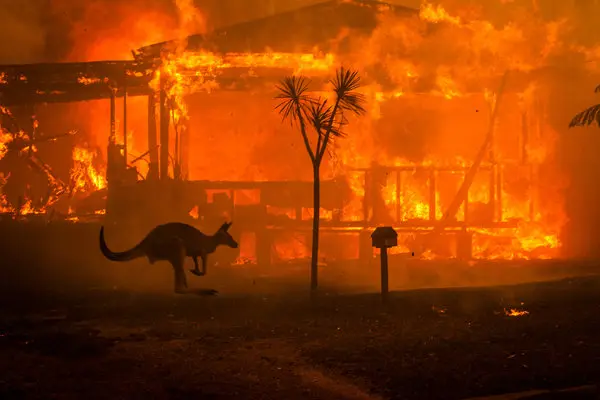Understanding the fires in Australia.

By Yasmin Elsouda, BA International Relations
The world watched in shock as a landscape larger than Belgium caught fire across New South Wales and Victoria in Australia. 80 people were killed not far from there in Indonesia, by flooding and landslides, the worst the country has seen since 2007. East Africa also experienced its worst flooding in two decades. These phenomena represent an intensification of extreme weather patterns underpinned by climate change.
The connection between these weather patterns is often unnoticed but can be explained by examining the Indian Ocean Dipole (IOD). The IOD is a temperature gradient that affects the surface temperature of the Indian Ocean from the edge of Africa to the edge of Australia, and is the large scale climate driver, that combined with global warming, is affecting Australia and East Africa’s weather. The IOD is currently experiencing a positive phase where winds come in from the east and shift warm water towards the edge of Africa, resulting in high levels of evaporation and therefore high levels of rainfall, hence the flooding. Surface water temperatures by Australia are low, and thus no evaporation and no rainfall occurs, explaining the droughts and bushfire seasons. The strength of the positive IOD makes this bushfire season so intense. The IOD has seen an extreme shift in water temperatures combined with record rises in Australian temperatures and abnormally dry vegetation.
Climate change and the warming of the planet is directly responsible for these phenomena and it is likely that intense mega-fires like these will become the new norm.
Conservative estimates suggest that over half a billion animals have perished in the Australian fires. 29 people have been reported dead. More than 24 million acres of land has been destroyed, and plant regrowth will be much slower than usual due to the intensity of the fires. These fires appear to be the latest mega blazes following the Amazon fires in August 2019 and the California fires earlier in 2018. Climate change and the warming of the planet is directly responsible for these phenomena and it is likely that intense mega-fires like these will become the new norm.
In Australia, fire is actually needed for ecosystems to thrive and aboriginal people have used cultural burns for over 50,000 years to maintain a balanced environment. Mega-fires like the one we witnessed in Australia are actually preventable if indigenous knowledge of the land was utilised. Indigenous people are urging a revival of their traditional knowledge as it is the only way to prevent such a disaster from happening again. This would involve caring for the forest floor, dynamically examining the needs of each landscape, and seasonally burning off forest fuel (twigs, debris, leaves). Indigenous communities have not been allowed to continue their fire practices, which have left these lands more vulnerable to mega blazes. This is a direct consequence of the colonial suppression of indigenous forms of knowledge production, especially through the marginalisation of indigenous communities, and the erasure of oral histories.
The UK Meteorological Office predicted that 2020 would witness one of the largest annual jumps of Carbon Dioxide in the atmosphere due to the fires, as not only did the burning release carbon emissions, but it also destroyed the vegetation that would normally absorb it. Furthermore, the UK MET office suggests that the fires could be responsible for a one to two percent increase in the rate of acceleration of the rise of atmospheric carbon dioxide. This is indicative of the global consequences of the fires that blackened New Zealand’s glaciers.



